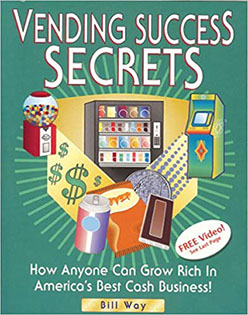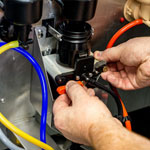Vending Machine Secrets
Vending machines are low maintenance, but in most cases you need to know what sort of market you're getting into before you buy. Many business owners purchase vending units without doing the research. If you’re wanting to learn how to maintain your machines and maximize profit, here are some helpful steps you can follow.
Secret 1: Learn about the Industry
While you won’t need to go through extensive training to get into the vending machine industry, you’ll need to do some homework before starting your venture. With some market research, you can get an idea of how much time you’ll have to put into your company, the amount of money you’ll likely need to invest, and how long you’ll have to work before seeing a return on that investment.
Secret 2: Choose the type of Business you Want
When starting a vending machine venture, you can either open a new company, or buy an existing business. If you start from scratch, you’ll have the benefit of more flexibility, so you can start small with just a few machines and grow over time.

It could also mean significantly more work, though, as you’ll need to build a network of suppliers and do the legwork of finding locations.
In comparison, if you choose to buy an existing company, you’ll save time on buying or renting machines and scouting locations. However, you’ll still need to check out those locations to see how they’re doing. You’ll also want to review the numbers to be sure that you’re buying a company that will allow you to make a profit.
Secret 3: Choose the Right Locations
Location is everything in the vending machine industry. Choosing the best locations will make all the difference in whether your business is successful. Look for locations that have the following qualities: significant foot traffic throughout the week, buildings with at least 50 employees, spaces without vending machines in place and without other food options available, and places where people frequently have to wait in line.
Secret 4: Know the Costs
As with any business venture, there are costs associated with starting a vending machine business, and you’ll need to consider them when deciding whether opening this type of company is right for you. Here are some of the costs to consider:
Vending Machines – The obvious cost to consider is the machines themselves. On average, a machine will cost between $3,000 to $5,000. That number will vary based on where you purchase the machines and whether they are new or used. Insurance and Taxes – Just like with any other business, you’ll have to factor insurance and tax costs into your budget with a vending machine company. Find out about tax licenses and liability insurance policies before starting. Ongoing Costs – Rent and royalties might be figured into your contracts with the locations that host your machines. Those costs will vary on a monthly basis, but you should be able to determine approximately how much you’ll have to pay on average. Maintenance – Schedule regular visits to your sites to check on your machines and ensure they’re all functioning properly. In addition, you should factor in repairs and replacements into your budget.
Secret 5: Choose your Products
Stocking your machines with inventory might not seem like a major task, but you should put some thought into the products you’re offering in each location to make the most profit. Think about the customers at each location and what they’ll be looking for.
Snacks are the obvious choice. You can stock your machines with chips, candy, and soda and do well in most locations. If you want to change things up, you can get follow the trend of healthy vending machines. According to Forbes, cities across the country are putting legislation into effect that will create rules like making 40 percent of vending machine products healthy options.
Secret 6: Invest in your Business
Once you’ve learned about the vending machine industry and made the decision to start your business, it’s time for the real work to begin. Although it can be a great industry to be a part of, you might benefit from applying for a small business loan to cover initial costs and keep your machines stocked with fresh inventory.



